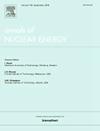Uncovering the potential of ZnO and CaO in shielding and density enhancement for borate glass systems
IF 1.9
3区 工程技术
Q1 NUCLEAR SCIENCE & TECHNOLOGY
引用次数: 0
Abstract
In the current work, the physical and radiation shielding properties for a glass system composed of (65-x-y) B2O3 + 10BaO + 10Na2O+(10 + x) ZnO+(5 + y) CaO; x = y = 0, 5, 10, and 15 mol% were examined experimentally. The density of the prepared glass samples was examined using the Archimedes method, where the density of prepared samples increased between 3.126 ± 0.066 g/cm3 and 3.731 ± 0.076 g/cm3 when the B2O3 compound was partially substituted by ZnO and CaO compounds. Additionally, the narrow beam transmission method and a 2″ × 2″ NaI (Tl) scintillation detector were utilized to measure the γ-ray shielding ability of prepared glass samples over an energy range of 0.662–1.332 MeV emitted by the radioactive sources Cs-137 and Co-60. The experimental measurements were also validated using the Monte Carlo simulation method. The difference between the two approaches is ±5 %. The measurements depict an enhancement in the linear attenuation coefficient with increasing the B2O3 substitution by ZnO and Ca compounds. The linear attenuation coefficient increases by 17.83 %, 18.30 %, 18.22 %, and 18.14 % at 0.662 MeV, 1.173 MeV, 1.252 MeV, and 1.332 MeV, respectively, as ZnO + CaO rise across the concentration of 15 mol%–45 mol%.
求助全文
约1分钟内获得全文
求助全文
来源期刊

Annals of Nuclear Energy
工程技术-核科学技术
CiteScore
4.30
自引率
21.10%
发文量
632
审稿时长
7.3 months
期刊介绍:
Annals of Nuclear Energy provides an international medium for the communication of original research, ideas and developments in all areas of the field of nuclear energy science and technology. Its scope embraces nuclear fuel reserves, fuel cycles and cost, materials, processing, system and component technology (fission only), design and optimization, direct conversion of nuclear energy sources, environmental control, reactor physics, heat transfer and fluid dynamics, structural analysis, fuel management, future developments, nuclear fuel and safety, nuclear aerosol, neutron physics, computer technology (both software and hardware), risk assessment, radioactive waste disposal and reactor thermal hydraulics. Papers submitted to Annals need to demonstrate a clear link to nuclear power generation/nuclear engineering. Papers which deal with pure nuclear physics, pure health physics, imaging, or attenuation and shielding properties of concretes and various geological materials are not within the scope of the journal. Also, papers that deal with policy or economics are not within the scope of the journal.
 求助内容:
求助内容: 应助结果提醒方式:
应助结果提醒方式:


